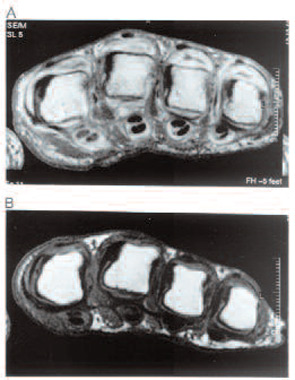Synovitis and Tenosynovitis: Contrast-enhanced MRI shows inflammation and damage simultaneously. (See Figure 1, right.) Studies in the wrist and metacarpophalangeal joints have demonstrated that the volume of synovitis can predict subsequent erosion progression. MRI studies have demonstrated a clear relationship between inflammation and progression of bony damage at the individual joint level.3 Longitudinal studies of MRI tenosynovitis at the wrist have also demonstrated predictive validity for subsequent tendon rupture.
Bone Edema: Bone edema is one of the most interesting features to emerge from MRI studies. Radiologists first reported this feature in the late 1980s. The appearance can refer to a range of pathological processes, and is descriptive for high signal lesions in bone on fat-suppressed or STIR images. In RA, bone edema refers to a pathological process that spans the continuum from activity to damage. Early studies demonstrated that bone edema is proportional to the adjacent degree of synovitis; recent studies have confirmed that areas of edema represent an inflammatory cell infiltrate or osteitis.4 If this osteitis persists, then trabecular bone loss occurs and an erosion is formed. However, effective treatment can reduce the early bone edema lesion and thereby stop the erosion formation.

MRI in RA Research
MRI is ideal for studies on pathogenesis and therapeutic outcome because of its increased sensitivity for bony damage and ability to simultaneously visualize inflammation. Studies have demonstrated that imaging one wrist and four metacarpophalangeal (MCP) joints in a single hand is more sensitive (by a factor of 2.5) than bilateral hand and feet radiographs in detecting erosion progression over a 12-month period.5 Studying synovitis in RA trials generally requires intravenous contrast use and is often limited to studying either a single wrist or four MCP joints.
Quantification of MRI-detected RA pathology is continually improving. There are detailed volumetric methods for measuring erosion size and synovitis volume. Furthermore, dynamic contrast enhanced MRI can be used to assess synovitis, although generally it is limited to single site studies. One of the most commonly used MRI scoring systems is the RA MRI score developed by OMERACT, which is a semi-quantitative score evaluating synovitis, bone edema, and erosions. This score has been validated in a number of studies. Quantitative whole organ image analysis methods are under development and may be available within the next few years.
